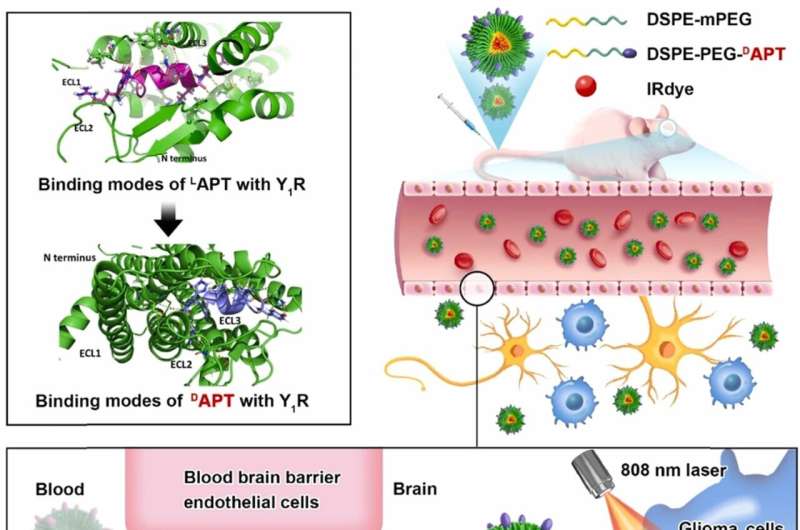The D-peptide ligand of Y1 receptor serves as nanocarrier crossing the blood brain barrier and targets gliomas . Credit: NIMTE
A research group led by Prof. Wu Aiguo at the Ningbo Institute of Materials Technology and Engineering (NIMTE) of the Chinese Academy of Sciences (CAS), in cooperation with Prof. Dan Larhammar's group at Uppsala University, has proposed a D-peptide ligand of neuropeptide Y receptor Y1, which can serve as nanocarriers to facilitate the traversal of the blood brain barrier (BBB) and thus targets gliomas efficiently. Results were published in Nano Today.
Cancer diagnosis and treatment of tumors has become an important scientific issue of common concern in multidisciplinary fields such as biology and materials science. The BBB restricts the entry of drugs into the brain tissue, hindering the effective diagnosis and treatment of brain tumors, such as gliomas.
Based on structure-guided design in the lab, researchers at NIMTE developed a D-peptide ligand of Y1 receptor, D[Asn28, Pro30, Trp32]-NPY(25-36)( DAPT).
Experimental and computational validation results indicate that when interacting with Y1 receptor, DAPT possesses higher affinity than the corresponding peptide with standard L-amino acids (LAPT), since the quantity of hydrogen bonds for DAPT is 2.5 times higher than LAPT.
In addition, a transcytosis experiment was conducted by virtue of an in vitro BBB model, demonstrating that DAPT modified nanomicelles exhibit superior efficiency in crossing the BBB comparing with LAPT and can specifically targets gliomas.
According to in vivo studies, DAPT nanomicelles show great potential in improving photothermal therapeutic efficacy and photoacoustic tumor imaging efficiency when loaded with a near-infrared photosensitizer IRDye780.
This study sheds light on the mechanism exploration of the neuropeptide Y crossing BBB and facilitates the accurate diagnosis and treatment of gliomas and other central nervous system diseases.
More information: Yanying Li et al, A D-peptide ligand of neuropeptide Y receptor Y1 serves as nanocarrier traversing of the blood brain barrier and targets glioma, Nano Today (2022). DOI: 10.1016/j.nantod.2022.101465
Journal information: Nano Today
Provided by Chinese Academy of Sciences























